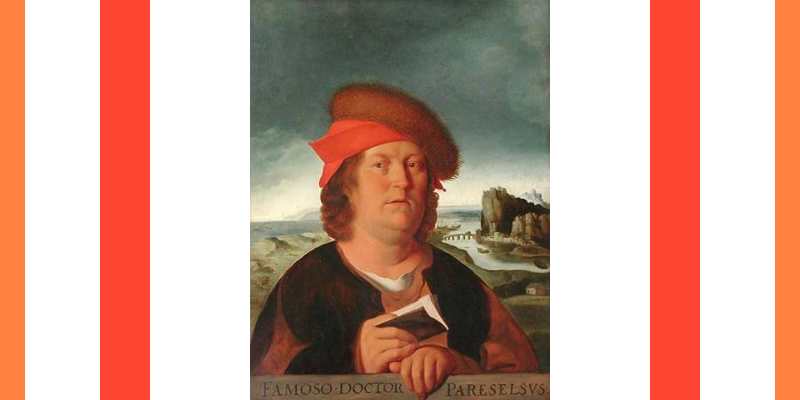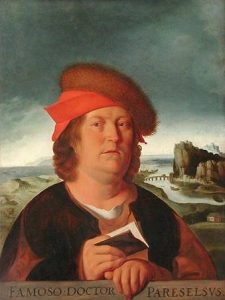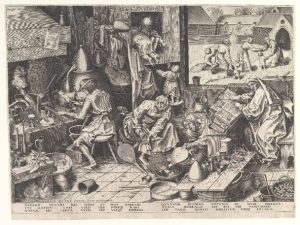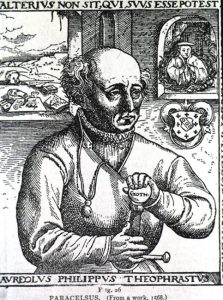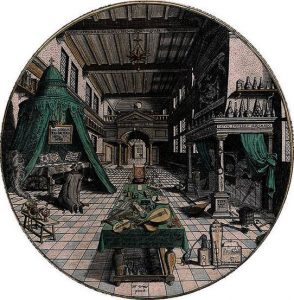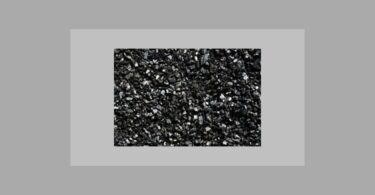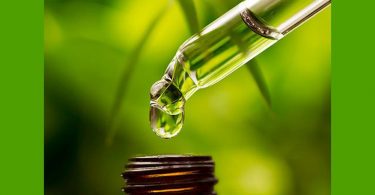Paracelsus was a sixteenth centurySwiss German philosopher, physician, botanist, astrologer and general occultist. He is credited asnot only declaring: “what makes a man ill also cures him” – presaging a maxim of homeopathy,simillimumsimilibuscurentur – but also credited with being the founder of toxicology.
But was he more homeopathic, say, than allopathic? “For the most part, Paracelsus was an advocate and practitioner of natural magic, and much of what constituted natural magic for “Paracelsus represented a fund of sound observations of a kind prerequisite for work in the experimental sciences developed in the course of the ensuing century” (Webster, 1982).It should be noted that in early modern Europe, ‘magic’ was the term given to the study and manipulation of many of those phenomena thatcould not be explained by the science of the time. Paracelsus certainly acquired a ‘magical’ view of the world but was this the inspiration that apparently turned him into an empirical investigator of Nature? Let us investigate whether his natural ‘magic’ was really “a fund of sound observations” by comparing this proposition with Paracelsus’ own practise to see if his unique view of the world was indeed the inspiration that turned him into a scientist.
This Christian scriptural extract:“Honor the physician for the need thou has of him: for the most high hath created him” Ecclesiasticus 38:1 – was quoted by many Paracelsians a century after Paracelsus’ deathand summed up the physical and spiritual aspects of the distinctive form of medicine that Paracelsus left. Paracelsus’ full and original namewas Theophrastus Philippus Aureolus Bombastus von Hohenheim (1493-1542) but he later called himself Paracelsus when he was thirty-four. Although Paracelsus had been born a Catholic, his practise of medicine was Protestant in principle, with his spiritual vision being more a natural philosophical view of the world. He was not alone – ‘Renaissance Man’ frequently leaned towards ‘magic’ to make sense of the surrounding turmoil prevalent in those times. However, before looking at Paracelsus’ distinctive form of natural ‘magic’, it would be useful to investigate his family and social background first to see how they had influenced him and to throw some light on the complexities of Paracelsus’ view of the cosmos.
The ophrastus was born in 1493 in Einsiedeln, Switzerland and at nine years of age moved to Villach in Carinthia, close to The Tyrol which was a boom town mining area owned by the affluent Fuggers, within the Holy Roman Empire. His father was a respected physician there who had obtained his MD further north at Tubingen in Further Austria. Herr Doctor von Hohenheim taught his son mining, mineralogy, botany and natural philosophy, grounding him in an empirical approach to the sciencesand where Theophrastus would have observed his efforts to cure ailments common to thriving industrial areas, like the miner’s diseases of silicosis and tuberculosis (Paracelsus, 1533). His father’s practice would have followed the classic Galenic system with possibly some Swiss folk cures.
Theophrastus’ education did not end there: at twenty, his father sent him south for a cutting-edge medical education in a university in Italy where he managed to gain only a minor degree at the humanist University of Ferrara with its illustrious lecturer Leoniceno (1428-1524);the minor degree was no doubt due to his increasinganti-Galenic attitude. According to Pagel (Pagel, 1974)this lesserdegree onlyenabled him to practise merely as a surgeon, and not as a fully-fledged physician.
Andso this volatile and impressionable young Swiss student drifted about, picking up medical knowledge where he could from either other Italian universities or various artisans and vagrants. Theophrastus also furthered his studies with atypical Church figures like the leading occultist (Cornelius) Agrippa von Nettesheim (1486-1535), and claimed to have been educated by the renowned Abbot of Sponheim, Johannes Trithemius (1462-1516), an exponent of magic and mysticism. As a result, Theophrastus became thoroughly imbued by mysticism and the occult.
However, mysticism and the occult were not always viewed with approval at that time because alchemists frequently took advantage of people who were ill. This allegorical print above (1558)is satirical and portraysan alchemist vainly pursuing the philosopher’s stone for gold – at the same time, his expensive alchemical ministrations have reduced a family to poverty. In the background the unfortunate family flee, forced to receive charitable support from a nearby hospital. History repeats itself: contemporary society is still, by and large, having to resort to BigPharma’smedical monopoly of often-expensive (chemical, or other noxious product) medicines for healing – the only difference being that the modern ‘alchemists’ of BigPharma have finally managed to turn their mineral stones into a lot ofgold.
Theophrastus was then employed by the Venetian Republic as a military surgeon, which took him to the Mediterranean and the Middle East, where he was also probably employed by the Danish king, Christian II. He later gained valuable practical experience in the Fugger mines near Villach and Schwaz, which would have exposed him to the ongoing plight of the working-man’s health which, alongsidetheir folk cures and mining myths,became very important to him as a proactive ‘Christian’ healer.
Yet the most important part of Theophrastus’ education originated through his penchant for travelling throughout Central Europe where he would have gained a lot of medical experience. However, wherever he went, he inevitably came in conflict with authority figures,relationships whichended abruptly in self-inflicted expulsion due to his philosophical outlook. Another reason for his restlessness may have been due tohis father’sdisappointment in hispoor academic achievement in Italy, so the disenfranchised Theophrastus becamea wandering peripatetic. It should also be borne in mind that most European establishments followed what he considered were the pagan rites and philosophies of Galen and Aristotle, which he abhorred. Nevertheless, Theophrastus did have an opportunity to establish himself because around 1527 when he wasthirty-four, he is recorded as having given first-rate medical advice to two eminent gentlemen, Froben the publisher and the humanist Erasmus, both of which led to his important appointment as Basel’s town physician.
However, after only a year this “Luther of Medicine”, as his enemies later called him, was ejected from Basel because: firstly he insisted on using his own syllabus based on his own personal experiences instead of the classical writings; secondly he admitted non-scholarly barber-surgeons (which was unheard of); and thirdly he lectured in German instead of Latin(one of the languages used by scholars and especially physicians). Nevertheless, his journeying among simple people had led him to folk cures from different European localities where he discovered that specific diseases had specific cures found in Nature, and that “species and diseases were localized phenomena” (Webster, 1982), all of which opposed the totality theory of Aristotelian medicine. These new concepts of disease and medicine of Paracelsus foreshadowed the reductionist view of medicine.
Furthermore, the medical authorities in Basel were annoyed when Paracelsus insisted that the esteemed learned practise of medicine by the highly-respected physicians be combined with lowly manual surgery. Coincidentally, this novel approach of Paracelsus was very similar to the different approachof the well-known medieval surgeon Guy de Chauliac (1298-1368) who wrote, “… the surgeon working in his art should know the principles of medicine” (Chauliac).
In a wider social context, Paracelsus was surrounded by health and political crises that affected all levels of society throughout Central Europe at that time. Plague wasdestroying most of the continent: in 1527, the Duke of Saxony even ordered Martin Luther out of Wittenberg to avoid catching it. Death was commonplace. Folk cures and ‘magic’ would have been resorted to but in many cases, in view of the extreme destruction of life all around, these methods would have had very little benefit. The great pox was rife and most probably it wasa devastating visitor in boomtown areas: one sufferer,a certain Joseph Gruenpeck (1473-1532), is recorded as saying that in recent times he had seen scourges, horrible sicknesses and many infirmitiesfrom all corners of the earth, which would have included syphilis.
There were changes on the political front too: in 1526, princes could now make their own decisions (the Diet of Speyer), and in 1529, the Schmalkadic League enabled several princes to become Lutherans, which meant that the faith of the prince determined the faith of the common people living on his lands. This would have changed the principles of the practise of medicine from what were considered as ‘pagan’ practises to ‘Christian’ ones. In addition, the Habsburg’s territories were continually being challenged by the Ottoman Empire and so Europe would have literally seethed with military campaigns. All of this, together with the Reformation of 1517, would have wrought total turmoil in society. It is clear that these complexities in Paracelsus’ educational and social background would have had an enormous influence on his worldview.
The distinctive form of Paracelsus’ natural philosophy worldview is now considered – it must be noted that Paracelsus worked within a ‘magical’ Renaissance tradition that would have caused tensions with the scholarly Aristotelianism of humanists because he was seeking a more Christian-based medicine than what he considered to be the current pagan one. Basically, he transformed Aristotle’s four elements of water, earth, air and fire to nonmaterial prime matter from which essences, or seeds, from God were formed; and then he superimposed his tria prima of salt, sulphur and mercury which became the three developmental principles within matter.
Finally Paracelsus discarded the traditional medical system of balancing the humors with opposites(n.b.using opposites to heal is one of the principles of allopathy). But Paracelsus felt that a specific cure for the specific disease could be found in the Book of Nature and instigated a doctrine of signatures, reiterating his tutor Agrippa who believed that Nature itself was the source of knowledge, rather than knowledge from the ancients. He saw a strong correspondence between the operations of nature in the wider universe and the operations in the body, in the same way as Tycho Brahe did: “To deny the power and influence of the stars is to detract from divine wisdom and influence” (Webster, 1986).
Paracelsus’ natural philosophy promoted a human-centered world where individuality was paramount and where the onus was on the individual to discover his salvation through the medicinal quinta essential found in Nature which had been created by God for that very purpose. This concept will be familiar to homeopaths. On the other hand he also believed this quinta essential or final substance could only be extracted from traceable material effects using a philosopher’s stone. Paracelsus believed that man could only feel through his experience rather than relying on reason operating on objects viewed as external to him, as the subjective view, he believed, was personal contact with God. His natural philosophy appeared to have had its roots in his mining background, which would also have led him to firmly believe that “alchemy is nothing but the art which makes the impure into the pure through fire” (Paracelsus, 1520). Nevertheless, even though Paracelsus had renounced scholasticism and the ancients, his anthropocentric outlook corresponded with Aristotelian egocentricity as he had been influenced by Hellenistic philosophy during his formative years. The revolutionary heliocentric theory in Copernicus’ De Revolutionibus (published in 1543) would only appear after Paracelsus’s death.
But wasthis natural philosophy, the occult arts, really a fund of sound observations? To verify, it is necessary to demonstrate how natural ‘magic’can be viewed as empirical. Natural philosophy operated on the premise that most bodies had unseen powers that could affect other bodies, that is to say, the effects of planets on the earth and people, or the effects of plants and chemicals as internal medicine for the body. They were called occult because their powers were not detected by the senses – their innate activity and effect on the human organism was unseen to the human eye. Aristotelians had problems with this at first because natural philosophy was based on what the senses detected – heat, cold, dry, wet.
Aristotelians were practical – to accept the imponderable was to admit defeat. In the medical practises of that time, the intrinsic powers within materiamedicacould not always be explained by the senses, but as more and more botanical or mineralogical substances were introduced into medical use, so their active properties and ensuing results could not be disputed. Results were palpable. Aristotelians firstly suggested the effects were due to a natural causation, like unseen spirits or tiny particles, but significantly they had to accept their authenticity “by pointing to the empirically undeniable reality of their effects” (Henry, 2002). This clearly was the start of experimental sciences because sound observations could be made on the reliable effects on the human organism fromtheir available materiamedica.
Finally, an analysis should be made as to whether Paracelsus made sound observations, bearing in mind his practise was based upon a natural philosophical worldview. Remember he grew up in a mining milieu and observed miners’ ailments at close hand and this, together with a neo-Platonic background, meant Paracelsus connected diseases with the spirits of minerals or metals, which led him to believe the core of disease, the starting point as it were, was spiritual. His practice of astrology directed him to what he believed were new diseases, writing in “Seven Defensiones”: “astronomy … teaches me to recognise such diseases” (Paracelsus, 1538), and he gave these diseases new names; a forerunner of allopathic diagnoses and the naming of diseases.
Even with Paracelsus’s patchy classical education, he was confident to write, “since, however,Astronomiais rejected by physicians, these diseases and many others, together with their true causes, can be neither recognized nor understood” (Paracelsus, 1538). Therefore, obliquely, many ‘new’ diseases started to be recognised, named and treated. Paracelsus held that the macrocosm was the source of disease: “the fog has its origin in the firmament, there is also a fog in the mine, from which the miners’ sickness can arise … it comes from the sphere Galaxae” (Paracelsus, 1533), illustrating his macrocosm-microcosm hypothesis.
Paracelsus also reasoned that as minerals and chemicals were found in the body of the earth, so they could be prescribed as internal medicines to work in the body of man – a ground-breakingapproach (no pun intended) that mirrored the doctrine of signatures. It was principally Paracelsus whointroduced chemicals into medicine, as seen in seventeenth century pharmacopoeias, and it was he who coined the term, ‘iatrochemist’. He also introduced practical alchemical terms like distillation, extraction, separation and reduction and “his terminology – Experienz, Experiment, Erfahrung etc. – was to dominate the experimental philosophy of the seventeenth century” (Webster, 1982).
For instance, “Bismuth was one of the substances which he specially analysed and which he catalogued as a half metal. From this substance Madame Curie has eliminated polonium […].He discovered zinc […]. It was one of the many additions he made to pharmacy. Amongst them were preparations of iron, of antimony, of mercury, and of lead. Sulphur and sulphuric acid were items of especial interest and experiment … “(Stoddart, 1911). Paracelsus did not compound herbs like Galen but isolated their active principles and observed their effects, which was significant for the development of organic and inorganic chemistry. Apart from two pamphlets on the pox and a few booklets on astrological prophecy, the only work he had published while alive was his Big Book of Surgery in 1536.
After Paracelsus’ observations of heroic overdosing in medical practice – “I saw that nothing resulted from [doctors’] practice but killing and laming” (Porter, 1999) – he decided to promote moderate dosing saying, “a great artist … acquired his ability and skill through the experience of his hands” (Paracelsus, 1520) demonstrating his empiricism. And initialising early chemical analyses, hewrote: “sickness was to be understood not by conventional urine inspection (uroscopy) but by chemical analysis using distillation and coagulation tests” (Porter, 1999). But he also believed there was an empathy between individuals and nature: “he who would explore nature must treat her books with his feet” (Porter, 1999). Paracelsus held that simple folk and their remedies was the path to salvation because he had observed, “an unlettered peasant heals more than all of them with all their books and red gowns” (Paracelsus, 1538). Thus, Paracelsus’ ‘magical’ worldview does indeed unitewith an experimental practice reliant on observation of outcomes. And this earlyform of research marked a move towards scepticism and empiricism that were to become the cornerstones of modern medical science (Pagel, 1958).
In conclusion, Paracelsus appears to have been an alchemical experiment himself – one who fashioned his own philosophical stone of mysticism which was later discarded by the scholastic establishment. His medical career began with a soupcon of Aristotelianism combined with neo-Platonism, Gnosticism, cabbalism and some Central European folk cures. A zealous fire was applied and the resulting amalgamation of alchemy, chemistry, religion and cosmology produced a distillation containing the quintessence of what was to becomeexperimental chemistry and allopathic medicine. Natural philosophy for Paracelsus, then,proved to be a fund of sound observations that led to the empirical sciences a century later. His ‘magical’ worldview was an inspiration that turned him into an experimental investigator of Nature, a populariser of chemical remedies andapioneer of contemporary global medical science and allopathic medical practise.
References:
1 Charles Webster (1982),From Paracelsus to Newton: Magic and the Making of Modern Science, Paracelsian prophecy and natural magic (Cambridge: Cambridge University Press), pp.15-27
2 Charles Webster (1982), From Paracelsus to Newton: Magic and the Making of Modern Science,Paracelsian prophecy and natural magic (Cambridge: Cambridge University Press), pp.48-59
3 Paracelsus ‘On the Miners’ Sickness’ – The Second Tractate on the Origin and Birth of the Miners’ Sickness (1533-4), Four Treatises of Theophrastus von Hohenheim called Paracelsus, ed. Henry Sigerist (Baltimore, MD: John Hopkins University Press, 1941), pp61-4
4 Pagel, W (1974), ‘Paracelsus’, in C. C. Gillespie (ed.), Dictionary of Scientific Biography, vol 10, (New York: Scribner), p.304
5 Charles Webster (1982),From Paracelsus to Newton: Magic and the Making of Modern Science, Paracelsian prophecy and natural magic (Cambridge: Cambridge University Press), pp.48-59
6 Guy de Chauliac, Great Surgery in James B. Ross and Mary M. McLaughlin (eds), The Portable Medieval Reader (Harmondsworth, Penguin Books, 1977), pp. 640-9
7 Charles Webster (1986), ‘Puritanism, separatism and science’, in D. Lindberg and R. Numbers (eds), God and Nature: Historical Essays on the Encounter between Christianity and Science, Primitive purity of the Scriptures, (Berkeley, CA: University of California Press), pp. 204-13
8 Paracelsus, ‘Alchemy, Art of Transformation’ [1520s-1530s], trans. Norbert Guterman, in Jolande Jacobi (ed.), Paracelsus: Selected Writings (London: Routledge, Kegan and Paul, 1951), pp. 215-23
9 John Henry (2002),The Scientific Revolution and the Origins of Modern Science, Magic and the Origins of Modern Science, (NY: Palgrave), p.65
10 Paracelsus, ‘Seven Defensiones’ [1538] The Other Defence Concerning the New Diseases and Nomina of the Above-Mentioned Doctor Theophrastus in Four Treatises of Theophrastus von Hohenheim called Paracelsus, ed. Henry Sigerist (Baltimore, MD: John Hopkins University Press, 1941), pp. 16-24
11 Paracelsus, ‘Seven Defensiones’ [1538] The Other Defence Concerning the New Diseases and Nomina of the Above-Mentioned Doctor Theophrastus in Four Treatises of Theophrastus von Hohenheim called Paracelsus, ed. Henry Sigerist (Baltimore, MD: John Hopkins University Press, 1941), pp. 16-24
12 Paracelsus ‘On the Miners’ Sickness’ – The Second Tractate on the Origin and Birth of the Miners’ Sickness (1533-4), Four Treatises of Theophrastus von Hohenheim called Paracelsus, ed. Henry Sigerist (Baltimore, MD: John Hopkins University Press, 1941), pp 61-4
13 Charles Webster (1982), From Paracelsus to Newton: Magic and the Making of Modern Science, Paracelsian prophecy and natural magic (Cambridge: Cambridge University Press), pp.48-59
14Roy Porter (1999), The Greatest Benefit to Mankind – A Medical History of Humanity from Antiquity to the Present (UK: Harper Collins), p.202
15 Paracelsus, ‘The Physician’s Remedies’ [1520s-1530s], trans. Norbert Guterman, in Jolande Jacobi (ed.), Paracelsus: Selected Writings (London: Routledge, Kegan and Paul, 1951), pp. 158-60
16 Anna M Stoddart (1911), The Life of Paracelsus, Theophrastus von Hohenheim, 1493-1541
(London: J Murray), p.53
17 Roy Porter (1999),The Greatest Benefit to Mankind – A Medical History of Humanity from Antiquity to the Present(UK: Harper Collins), p.203
18Roy Porter (1999),The Greatest Benefit to Mankind – A Medical History of Humanity from Antiquity to the Present(UK: Harper Collins), p.204
19 Paracelsus, ‘Seven Defensiones’ [1538] The Other Defence Concerning the New Diseases and Nomina of the Above-Mentioned Doctor Theophrastus in Four Treatises of Theophrastus von Hohenheim called Paracelsus, ed. Henry SigeristBaltimore, MD (John Hopkins University Press, 1941), pp. 16-24
20 Pagel (1958) W. Paracelsus: An Introduction to Philosophical Medicine in theEra of the Renaissance, (Basel and New York:Karger), p.51
Images:
Paracelsus By After Quentin Matsys (1456/1466–1530) – http://euromin.w3sites.net/Nouveau_site/mineralogiste/biographies/pic/paracelse.htm, Public Domain, https://commons.wikimedia.org/w/index.php?curid=43352
The Alchemist (1558) by Pieter Brueghel the Elder (OASC) http://www.metmuseum.org/art/collection/search/366817
Illustration of alchemist’s workshop from Heinrich Khunrath,AmphitheatrumSapientiae, 1595
Courtesy of the National Library of Medicine
https://www.nlm.nih.gov/exhibition/harrypottersworld/images/details/OB0061.jpg
Paracelsus
Courtesy of the National Library of Medicine

